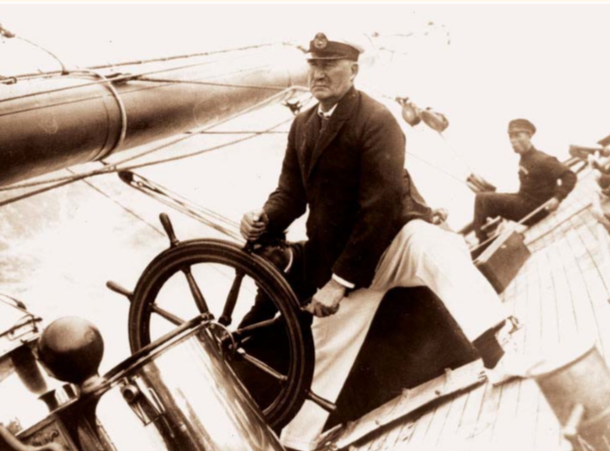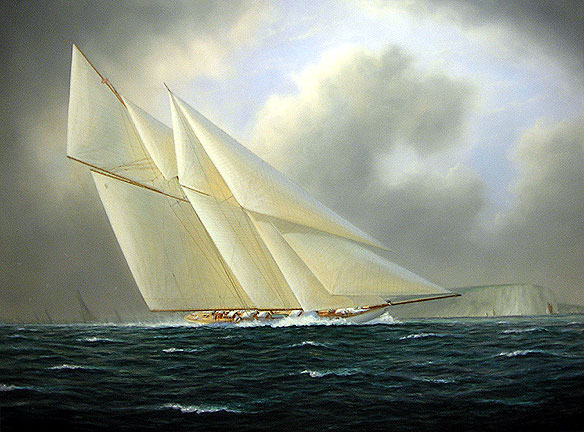
Type: Big Class
Westward Specifications:
LOA: 135’0″ / 41.14m – LWL: 96’0″ / 29.26m – Beam: 26’8″ / 8.12m – Draft: 16’11” / 5.15m – Hull Number: 692 – Designer: N.G. Herreshoff – Original Owner: Alexander S. Cochran – Christened by: Mrs A. Livingstone Beekman – Original Skipper: Charlie Barr – Last Owner: Thomas Benjamin Frederick Davis – Year Built: March 31, 1910 – Built By: Herreshoff Manufacturing Co. – Contract Cost $ 118,000 – Gross Displacement: 323 tons – Sail Area: 12,612 sq ft / 1,171.7sqm – Status: Destroyed (Scuttled on July 15, 1947)
Historical:
Alexander Smith Cochran was born on February 28, 1874, to William Francis Cochran and Eva Smith. His grandfather was Alexander Smith, founder of the Alexander Smith Carpet Company.
Cochran inherited his wealth from his parents and his maternal uncle Warren B. Smith who left Cochran the bulk of an estate estimated to be worth $40 million in 1902. Cochran was the inheritor and principal owner of Alexander Smith & Sons Carpet mills of Yonkers, which by 1929 was the largest carpet manufacturer in the world.
Cochran was a member of the New York Yacht Club. Initially not an enthusiastic yachtsman, he owned and raced the sloop Avenger in 1909 and won the Astor Cup. Cochran decided to build a schooner that could make the Atlantic crossing and compete well in Europe, and ordered the Westward built between 1909 and 1910 by Nathanael Herreshoff of the Herreschoff Manufacturing Company of Rhode Island. The Westward was a 96-foot-waterline steel schooner and was the largest sailboat the Herreshoff Company had made at the time. Cochran raced the yacht off England and Europe in 1910 with Charlie Barr as the skipper.
The season was a stunning success. Westward won every race in German waters and eight of nine in England. Cochran sold Westward to a German syndicate in 1911, having become interested in larger yachts. He was already having a large three-masted schooner Sett Call designed for him by William Gardner. Cochran decided to become an America’s Cup contender and asked Gardner to also work on an America’s Cup prospect for him. Vanitie was the result. Both Vanitie and Sett Call were built by the George Lawley and Sons Corporation of Boston.
In 1912 she sailed across the Atlantic to join the German fleet of steel schooners. Once there she continued to earn win first place finishes, but her time there was cut short by the Outbreak of World War I in 1914.
In 1919, after the war and pandemic, Westward was purchased as a war-prize by the flamboyant London financier Clarence Hatry, who restored her original name. Hatry had begun his rise to success by transporting Eastern European emigrants to the United States and Canada. He subsequently enriched his vast fortune with investments in photographic supplies, vending machines, and loan offices.
Unfortunately he had been only able to race Westward for one season, the Summer of 1919. In the economic downturn that followed the war, his empire had become increasingly shaky, and he had be forced to turn his attention away from Westward, as he found himself in dire circumstances. By the time he sold her in 1924, she had spent four years in retirement, mostly in a mud berth near Southampton.
In 1924 Westward’s new owner, London businessman Warwick Brookes, a keen yachtsman, known for racing Six- metres. He also owned and raced a famous Fife schooner, and other yachtsman were hopeful that he would be racing Westward. Instead she moved on to her fifth owner the same year.
Under TB Davis Stewardship
Davis was to go on to make his fortune in stevedoring in South Africa but his career was nearly cut short on his first voyage when the ship ran aground in heavy weather off the coast of Norfolk and he was carried away from the vessel when a rope snapped casting him adrift in a dinghy with the ship’s papers and valuables. He drifted for some time before being picked up by a Norwegian vessel, by which time the Satellite had refloated and returned to Southampton, to report him missing, presumed drowned. It has been recorded by historians, most notably George Balleine, in his Biographical Dictionary of Jersey, that he made it back to Jersey just in time to catch the end of his memorial service in St Luke’s church, much to the astonishment of the congregation, and his mother, who reportedly fainted. (somewhat fanciful version of events)
His passion was yacht racing, and in 1924 he bought the schooner Westward, wanting a vessel at least the equal of the Royal Yacht of his friend King George V. He raced Westward in European waters for ten years and developed a fierce and friendly rivalry with the King.
Following the death of the King in 1936 Davis more or less gave up racing. He had two Ailsa Craig 48-60 hp six-cylinder diesel engines fitted in, as well as other accoutrements designed to enhance comfort. Davis continued to cruise, including a trip to Norway and Sweden, until Westward was laid up in Dartmouth for the duration of the Second World War. Davis had moved back to South Africa, and died in Durban in 1942 at the age of 75. His will specified that if a new owner with sufficient means to maintain Westward could not be found, she should be sunk. Sadly no member of his family felt capable of looking after Westward, and after she had also been offered unsuccessfully to three different sail-trading establishments, the final clause of Davis’s will came into play. On July 15, 1947, stripped of all hardware, equipment and interior fittings she was towed out to the Hurd Deep, off Jersey, the Channel Islands. At 12:45 pm., the dynamite was ignited and Westward sank some 60 miles from her old friend Britannia.
Provenance. (The Wall of Remembrance – The Owners, Crew & Notable Guest):
(1910-1911) – Alexander Smith Cochran, manufacturer, sportsman, philanthropist, and Commander of the Order of the British Empire.
(1911-1919) – German Syndicate – Norddeutscher Regatta Verien (vessel renamed Hamburg II.)
(1919-1924) – London Financier Clarence Hatry (renamed vessel Westward) purchased as a war price.
(1924-1924) – London Businessman Warwick Brookes
(1924-1942) – Thomas Benjamin Frederick Davis, businessman, yachtsman and philanthropist. (Royal Cape Yacht Club of Cape Town, SA )
(1942-1947) – Estate of T.B. Davis – In accordance with T.B. Davis’ will Westward was offered to three sea training schools but they all declined, unable to maintain her on 15 July 1947 she was taken out into the English Channel where she was scuttled in the Hurd Deep.
Resources
Photo credit: Frank William Beken, 1910.
Tim Thompson – Schooner Yacht WESTWARD off Dover Cliffs
Oil (29″ x 37″)
Herreshoff Info
The Racing Schooner Westward
Herreshoff Museum

